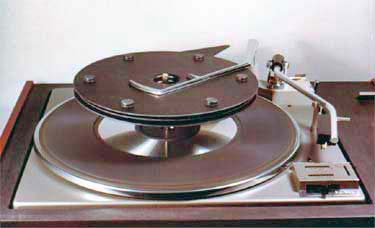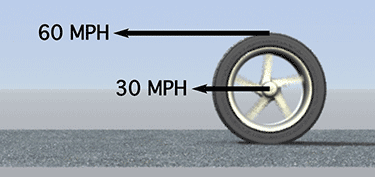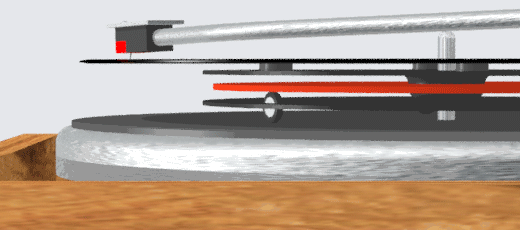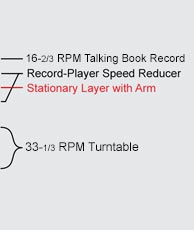Phonograph Speed Reducer
Phonograph Speed Reducer

This inexpensive device allows people to play 16-2/3 RPM talking-book records on 33-1/3 RPM record players. Developed by Steve Hines in 1972.
How it works:
This adapter uses the concept of a Lazy-Susan found on dinner tables, and in microwave ovens. The glass plate in a microwave rides around on three small wheels. The glass plate is turned by a motor. The ring turns at half the speed of the glass plate.

Another example can be illustrated with a car tire. The bottom of the tire does not move while in contact with the stationary road. If the car is driven at 30 MPH, the axel is moving forward at 30 MPH with the rest of the car. The top of the tire moves forward at 60 MPH (relative to the ground) in order to catch up and go around again. The important relationship is a 2:1 ratio between the top of the tire, and the half speed of the axle.

The speed reducer is made in three layers and drops onto the turntable like a record. The top and bottom layers are attached to each other through a clearance hole in the middle layer (with the protruding arm, shown in red below). Rotation of the arm is stopped when it comes in contact with the support for the stylus.
The turntable rotates at 33-1/3 RPM. The axles of three small rubber wheels, are attached to the lowest plate and ride around on the turntable. The weight and friction of the middle plate (shown in red) resting on the wheels, keeps the tops of the wheels stationary, causing the wheel’s axles to move at 16-2/3 RPM, half the speed of 33-1/3 RPM turntable.
Put another way, the bottom of the rubber wheels are moving on a 33-1/3 RPM turntable. The tops of the rubber wheels are prevented from moving due to the friction against the stationary middle plate (colored red). The axels of the rubber wheels, at the half height of the wheels, pushes the speed reducer around at half speed (16-2/3 RPM).
References:
- The Library of Congress.
- The American Printing House for the Blind declares themselves to be a non-profit organization, however declined to license this device because they would not be able to sell their more expensive record players to their blind customers.
- Audio Book Company, Pasadena, California
- Popular Electronics magazine, Aug. 1957 issue, p. 63-66, article about the Audio Book Co. speed-reducing adapter.
This is a technology announcement and license offer, not a product for sale. Please contact Steve Hines with questions.
USA
email: Steve@HinesLab.com
phone: 818-507-5812


